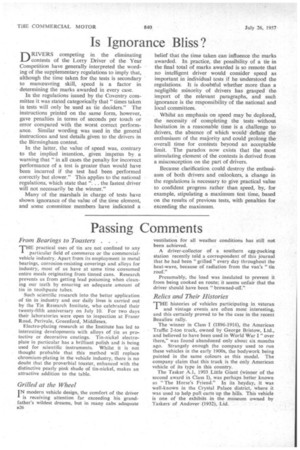Passing Comments
Page 34

Page 35

If you've noticed an error in this article please click here to report it so we can fix it.
From Bearings to Toasters . .
THE practical uses of tin are not confined to any particular field of commerce or the commercialvehicle industry. Apart from its employment in metal bearings, corrosion-resisting coverings and alloys for industry, most of us have at some time consumed entire meals originating from tinned cans. Research prevents us from getting lead poisoning when cleaning our teeth by ensuring an adequate amount of tin in toothpaste tubes.
Such scientific research into the better application of tin in industry and our daily lives is carried out by the Tin Research Institute, who celebrated their twenty-fifth anniversary on July 10. For two days their laboratories were open to inspection at Fraser Road, Perivale, Greenford, Middlesex.
Electro-plating research at the Institute has led to interesting developments with alloys of tin as protective or decorative coatings. Tin-nickel electroplate in particular has a brilliant polish and is being used for scientific instruments. Whilst it is not thought probable that this method will replace chromium-plating in the vehicle industry, there is no doubt that the proverbial toaster, enhanced with the distinctive pearly pink shade of tin-nickel, makes an attractive addition to the table.
Grilled at the Wheel
IN modern vehicle design, the comfort of the driver I is receiving attention far exceeding his grandfather's wildest dreams, but in many cabs adequate B26
ventilation for all weather conditions has still not been achieved.
A driver-collector of a southern egg-packing station recently told a correspondent of this journal that he had been " grilled " every day throughout the heat-wave, because of radiation from the van's "tin roof."
Presumably, the load was insulated to prevent it from being cooked en route; it seems unfair that the driver should have been "browned-off."
Relics and Their Histories
THE histories of vehicles participating in veteran and vintage events are often most interesting, and this certainly proved to be the case in the recent Beaulieu rally.
The winner in Class I (1896-1916), the American Traffic 2-ton truck, owned by George Bristow, Ltd., and believed to have been used in World War I" over there," was found abandoned only about six months ago. Strangely enough the company used to run these vehicles in the early 1900s, the bodywork being painted in the same colours as this model. The company claim that this truck is the only American vehicle of its type in this country.
The Tasker A.1, 1903 Little Giant (winner of the second award in Class I), was perhaps better known as "The Horse's Friend." In its heyday, it was well-known in the Crystal Palace district, where it was used to help pull carts up the hills. This vehicle is one of the exhibits in the museum owned by Taskers of Andover (1932), Lid.
According to Mr. J. Robinson, the driver of the 1914 HaWord ex-W.D. G.S. lorry, owned by J. H. Sparshatt and Sons, Ltd., which won the third award in Class I, this vehicle was discovered some two years ago in the yard of Alfred Stent and Sons (Havant), Ltd., leather manufacturers and woolskin dressers. It was found surrounded by skins, but the starting handle was turned and the engine started almost immediately. No new parts were required and the vehicle has been going well ever since.
The gaily coloured 1909 Renault van entered by James Neale and Sons, Ltd., Birmingham, recalled memories of Edwardian days, being one of the original London taxis. From 1912-1939, it was used for bread delivery in Yorkshire, but then disappeared until 1952, when it was rescued from a Leeds scrap yard and subsequently renovated.
Great interest was displayed in the Burrell showman's steam tractor of 1921, owned by Mr. G. R. Baker. Weighing 51 tons, this was originally exhibited at the Smithfield Show. For many years it was owned by Arnold Bros., Blackfield, and it was restored to its original condition during 1956-57. This tractor was driven from Andover to Sandbach (180 miles), to take part in the Foden Centenary celebrations in July, 1956.
Retired Inspector as Cabby
TAKING a holiday at a delectable, yet cheap, country-mansion hotel in Worthing under a Canton-trained manager, were recently a retired police inspector and his wife. To the surprise of the other guests, the couple had arrived in a brand-new oil-engined London taxi, which is the means by which this ex-official has decided to augment his retirement pay.
Presumably, he will be well-versed in the rules of the road—not to speak of the tricks of the trade.








































































































